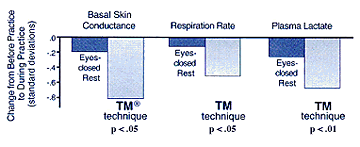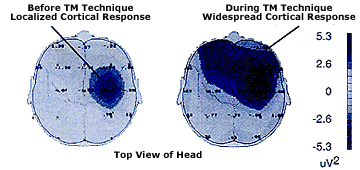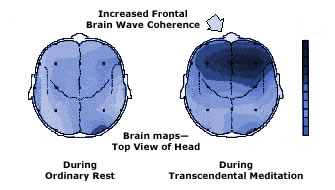Transcendental Consciousness Objectively Verified
The existence of Transcendental Consciousness can be objectively verified—due to the profound connection between mind and body. Changes in mental states are matched by changes in physiological functioning. Although scientists cannot tell what you are thinking about in the waking state, or envisioning in the dreaming state, they can clearly distinguish between the three major states of consciousness—waking, sleeping and dreaming. These three major states of consciousness can thus be identified by unique styles of physiological functioning—especially by particular combinations of metabolic rate and brain wave patterns.
This is all significant because, in the Vedic literature, the direct experience of the unified field of natural law during Transcendental Consciousness is said to take place in a fourth major state of consciousness. This profound state of inner peace is known in Sanskrit as samadhi ("unwavering mind"), or simply turiya ("the fourth”).
In the last several decades, researchers have verified the existence of this fourth state of consciousness by demonstrating that during Transcendental Consciousness the body and brain function in a unique manner—clearly distinct from waking, sleeping and dreaming.
|
| Physiological Indicators of Deep Rest through the Transcendental Meditation technique |
|
 |
|
A comparison (meta-analysis) of 31 previously conducted research studies showed that the experience of Transcendental Consciousness (as experienced during practice of the Transcendental Meditation technique) produced a level of physical rest and relaxation many times deeper than eyes-closed resting. Basal skin conductance measures the ability of the skin to conduct electricity; electrical flow increases when the skin perspires due to nervous tension. Thus, the sharp reduction of basal skin conductance during Transcendental Consciousness indicates deep relaxation. Respiratory rate also goes down during a state of relaxation, as does plasma lactate, a chemical by-product of stress and tension. These physiological changes occur spontaneously as the mind effortlessly settles to Transcendental Consciousness—a state of inner peace. Although the body also experiences a type of relaxation in the sleep state of consciousness, there is a major difference. While in the sleep state the mind loses awareness altogether, during Transcendental Consciousness the body rests deeply, but the mind becomes more alert (and the brain wave patterns differ markedly). Thus, Transcendental Consciousness is sometimes termed by researchers a state of restful alertness.
References:
- American Psychologist 42 (1987): 879–881.
- Science 167 (1970): 1751–1754.
- American Journal of Psychology 221 (1971): 795–799.
|
Mobilization of the Latent Reserves of the Brain
through the Transcendental Meditation technique |
|
 |
|
During Transcendental Consciousness, increased mental alertness is accompanied by dramatic changes in brain functioning. This study indicates that during this experience, hidden reserves in the brain are mobilized, enlivening brain functioning over a wide area. This research also showed that the brain's response to an external somatosensory stimulation (0–100 msec) is much more widely distributed across the cortex than it is in the period before Transcendental Consciousness—indicating increased alertness and responsiveness in brain functioning. This study, by Dr. Nicolai Nicolaevich Lyubimov, Director of the Moscow Brain Research Institute's Laboratory of Neurocybernetics, also indicates that there is an increase in the functional relationship between the two hemispheres. During the experience of the fourth state, therefore, large areas of the brain are both enlivened and integrated.
References:
- Proceedings of the International Symposium Physiological and Biochemical Basis of Brain Activity, St. Petersburg, Russia, (June 22–24, 1992).
- 2nd Russian-Swedish Symposium New Research in Neurobiology, Moscow, Russia, (May 19–21, 1992).
|
Increased Brain Wave Coherence
During Transcendental Consciousness |
|
 |
|
Twelve studies have shown that Transcendental Consciousness is also characterized by long-range coherence in brain wave patterns, as measured by electroencephalography (EEG). Ordinarily, during the waking state of consciousness, EEG patterns are scattered, disorderly, and rapidly changing. As the mind settles to Transcendental Consciousness, by contrast, brain waves tend to become rhythmic and orderly, and to move synchronously over large areas in the frontal regions of the brain (as shown here), extending eventually toward the posterior regions as well.
Researchers have long known that most experiences (sensory or cognitive) enliven only small, specific portions of the brain. The research above on the mobilization of brain reserves, and this research on long-range brain wave coherence, indicate that Transcendental Consciousness enlivens and coordinates brain activity over a wide area—stimulating what Maharishi Mahesh Yogi calls “total brain functioning.” In addition, studies on the Transcendental Meditation technique indicate that Transcendental Consciousness is accompanied by increases in the EEG index of restful alertness—slow alpha frequency power in the frontal cortex.
Taking these three studies together (which are backed by hundreds of others), Transcendental Consciousness is characterized by (1) a uniquely deep state of physiological rest and relaxation, and (2) the enlivenment and integration of large areas of the cortex (featuring significantly increased alpha power and long-range coherence). This physiological signature is unique to this fourth state of consciousness, and never appears in waking, sleeping or dreaming.
References:
- Science 167 (1970).
- Scientific American 226 (1972).
- American Journal of Physiology 221 (1971).
- Electroencephalography and Clinical Neurophysiology 35 (1973).
|
To move to the next Summary,
click here:

To continue with more detail on this topic,
click here:

|
|


